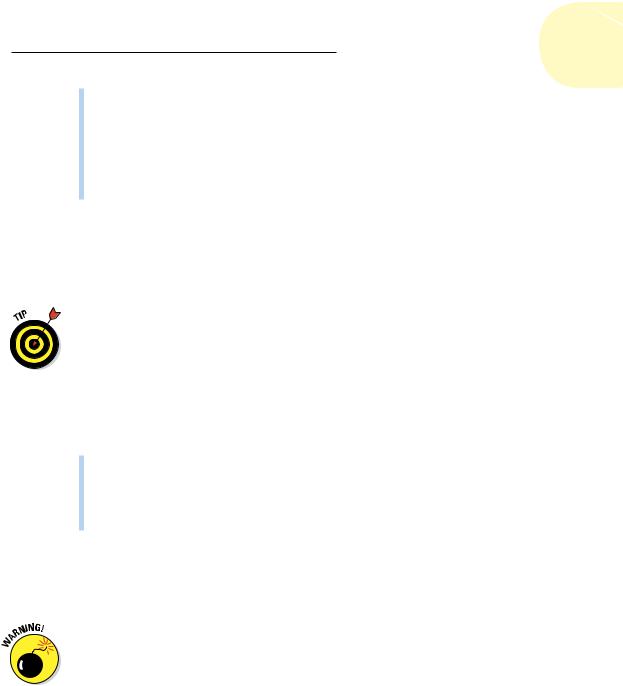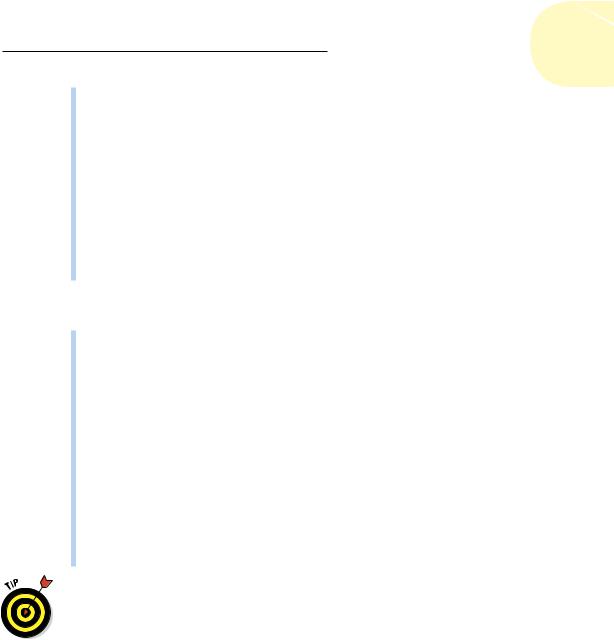
- •About the Authors
- •Dedication
- •Authors’ Acknowledgments
- •Table of Contents
- •Introduction
- •What’s Not (And What Is) in This Book
- •Mac attack!
- •Who Do We Think You Are?
- •How This Book Is Organized
- •Part I: AutoCAD 101
- •Part II: Let There Be Lines
- •Part III: If Drawings Could Talk
- •Part IV: Advancing with AutoCAD
- •Part V: On a 3D Spree
- •Part VI: The Part of Tens
- •But wait . . . there’s more!
- •Icons Used in This Book
- •A Few Conventions — Just in Case
- •Commanding from the keyboard
- •Tying things up with the Ribbon
- •Where to Go from Here
- •Why AutoCAD?
- •The Importance of Being DWG
- •Seeing the LT
- •Checking System Requirements
- •Suddenly, It’s 2013!
- •AutoCAD Does Windows (And Office)
- •And They’re Off: AutoCAD’s Opening Screens
- •Running with Ribbons
- •Getting with the Program
- •Looking for Mr. Status Bar
- •Let your fingers do the talking: The command window
- •The key(board) to AutoCAD success
- •Keeping tabs on palettes
- •Down the main stretch: The drawing area
- •Fun with F1
- •A Simple Setup
- •Drawing a (Base) Plate
- •Drawing rectangles on the right layers
- •Circling your plate
- •Nuts to you
- •Getting a Closer Look with Zoom and Pan
- •Modifying to Make It Merrier
- •Hip-hip-array!
- •Stretching out
- •Crossing your hatches
- •Following the Plot
- •A Setup Roadmap
- •Choosing your units
- •Weighing up your scales
- •Thinking annotatively
- •Thinking about paper
- •Defending your border
- •A Template for Success
- •Making the Most of Model Space
- •Setting your units
- •Making the drawing area snap-py (and grid-dy)
- •Setting linetype and dimension scales
- •Entering drawing properties
- •Making Templates Your Own
- •Setting Up a Layout in Paper Space
- •Will that be tabs or buttons?
- •View layouts Quick(View)ly
- •Creating a layout
- •Copying and changing layouts
- •Lost in paper space
- •Spaced out
- •A view(port) for drawing in
- •About Paper Space Layouts and Plotting
- •Managing Your Properties
- •Layer one on me!
- •Accumulating properties
- •Creating new layers
- •Manipulating layers
- •Using Named Objects
- •Using AutoCAD DesignCenter
- •Copying layers between drawings
- •Controlling Your Precision
- •Keyboard capers: Coordinate input
- •Understanding AutoCAD’s coordinate systems
- •Grab an object and make it snappy
- •Other Practical Precision Procedures
- •Introducing the AutoCAD Drawing Commands
- •The Straight and Narrow: Lines, Polylines, and Polygons
- •Toeing the line
- •Connecting the lines with polyline
- •Squaring off with rectangles
- •Choosing your sides with polygon
- •(Throwing) Curves
- •Going full circle
- •Arc-y-ology
- •Solar ellipses
- •Splines: The sketchy, sinuous curves
- •Donuts: The circles with a difference
- •Revision clouds on the horizon
- •Scoring Points
- •Commanding and Selecting
- •Command-first editing
- •Selection-first editing
- •Direct object manipulation
- •Choosing an editing style
- •Grab It
- •One-by-one selection
- •Selection boxes left and right
- •Perfecting Selecting
- •AutoCAD Groupies
- •Object Selection: Now You See It . . .
- •Get a Grip
- •About grips
- •A gripping example
- •Move it!
- •Copy, or a kinder, gentler Move
- •A warm-up stretch
- •Your AutoCAD Toolkit
- •The Big Three: Move, Copy, and Stretch
- •Base points and displacements
- •Move
- •Copy
- •Copy between drawings
- •Stretch
- •More Manipulations
- •Mirror
- •Rotate
- •Scale
- •Array
- •Offset
- •Slicing, Dicing, and Splicing
- •Trim and Extend
- •Break
- •Fillet and Chamfer and Blend
- •Join
- •When Editing Goes Bad
- •Zoom and Pan with Glass and Hand
- •The wheel deal
- •Navigating your drawing
- •Controlling your cube
- •Time to zoom
- •A View by Any Other Name . . .
- •Looking Around in Layout Land
- •Degenerating and Regenerating
- •Getting Ready to Write
- •Simply stylish text
- •Taking your text to new heights
- •One line or two?
- •Your text will be justified
- •Using the Same Old Line
- •Turning On Your Annotative Objects
- •Saying More in Multiline Text
- •Making it with Mtext
- •It slices; it dices . . .
- •Doing a number on your Mtext lists
- •Line up in columns — now!
- •Modifying Mtext
- •Gather Round the Tables
- •Tables have style, too
- •Creating and editing tables
- •Take Me to Your Leader
- •Electing a leader
- •Multi options for multileaders
- •How Do You Measure Up?
- •A Field Guide to Dimensions
- •The lazy drafter jumps over to the quick dimension commands
- •Dimension associativity
- •Where, oh where, do my dimensions go?
- •The Latest Styles in Dimensioning
- •Creating and managing dimension styles
- •Let’s get stylish!
- •Adjusting style settings
- •Size Matters
- •Details at other scales
- •Editing Dimensions
- •Editing dimension geometry
- •Editing dimension text
- •Controlling and editing dimension associativity
- •Batten Down the Hatches!
- •Don’t Count Your Hatches. . .
- •Size Matters!
- •We can do this the hard way. . .
- •. . . or we can do this the easy way
- •Annotative versus non-annotative
- •Pushing the Boundary (Of) Hatch
- •Your hatching has no style!
- •Hatch from scratch
- •Editing Hatch Objects
- •You Say Printing, We Say Plotting
- •The Plot Quickens
- •Plotting success in 16 steps
- •Get with the system
- •Configure it out
- •Preview one, two
- •Instead of fit, scale it
- •Plotting the Layout of the Land
- •Plotting Lineweights and Colors
- •Plotting with style
- •Plotting through thick and thin
- •Plotting in color
- •It’s a (Page) Setup!
- •Continuing the Plot Dialog
- •The Plot Sickens
- •Rocking with Blocks
- •Creating Block Definitions
- •Inserting Blocks
- •Attributes: Fill-in-the-Blank Blocks
- •Creating attribute definitions
- •Defining blocks that contain attribute definitions
- •Inserting blocks that contain attribute definitions
- •Edit attribute values
- •Extracting data
- •Exploding Blocks
- •Purging Unused Block Definitions
- •Arraying Associatively
- •Comparing the old and new ARRAY commands
- •Hip, hip, array!
- •Associatively editing
- •Going External
- •Becoming attached to your xrefs
- •Layer-palooza
- •Creating and editing an external reference file
- •Forging an xref path
- •Managing xrefs
- •Blocks, Xrefs, and Drawing Organization
- •Mastering the Raster
- •Attaching a raster image
- •Maintaining your image
- •Theme and Variations: Dynamic Blocks
- •Lights! Parameters!! Actions!!!
- •Manipulating dynamic blocks
- •Maintaining Design Intent
- •Defining terms
- •Forget about drawing with precision!
- •Constrain yourself
- •Understanding Geometric Constraints
- •Applying a little more constraint
- •AutoConstrain yourself!
- •Understanding Dimensional Constraints
- •Practice a little constraint
- •Making your drawing even smarter
- •Using the Parameters Manager
- •Dimensions or constraints — have it both ways!
- •The Internet and AutoCAD: An Overview
- •You send me
- •Send it with eTransmit
- •Rapid eTransmit
- •Bad reception?
- •Help from the Reference Manager
- •Design Web Format — Not Just for the Web
- •All about DWF and DWFx
- •Autodesk Design Review 2013
- •The Drawing Protection Racket
- •Autodesk Weather Forecast: Increasing Cloud
- •Working Solidly in the Cloud
- •Free AutoCAD!
- •Going once, going twice, going 123D
- •Your head planted firmly in the cloud
- •The pros
- •The cons
- •Cloudy with a shower of DWGs
- •AutoCAD 2013 cloud connectivity
- •Tomorrow’s Forecast
- •Understanding 3D Digital Models
- •Tools of the Trade
- •Warp speed ahead
- •Entering the third dimension
- •Untying the Ribbon and opening some palettes
- •Modeling from Above
- •Using 3D coordinate input
- •Using point filters
- •Object snaps and object snap tracking
- •Changing Planes
- •Displaying the UCS icon
- •Adjusting the UCS
- •Navigating the 3D Waters
- •Orbit à go-go
- •Taking a spin around the cube
- •Grabbing the SteeringWheels
- •Visualizing 3D Objects
- •Getting Your 3D Bearings
- •Creating a better 3D template
- •Seeing the world from new viewpoints
- •From Drawing to Modeling in 3D
- •Drawing basic 3D objects
- •Gaining a solid foundation
- •Drawing solid primitives
- •Adding the Third Dimension to 2D Objects
- •Creating 3D objects from 2D drawings
- •Modifying 3D Objects
- •Selecting subobjects
- •Working with gizmos
- •More 3D variants of 2D commands
- •Editing solids
- •Get the 2D Out of Here!
- •A different point of view
- •But wait! There’s more!
- •But wait! There’s less!
- •Do You See What I See?
- •Visualizing the Digital World
- •Adding Lighting
- •Default lighting
- •User-defined lights
- •Sunlight
- •Creating and Applying Materials
- •Defining a Background
- •Rendering a 3D Model
- •Autodesk Feedback Community
- •Autodesk Discussion Groups
- •Autodesk’s Own Bloggers
- •Autodesk University
- •The Autodesk Channel on YouTube
- •The World Wide (CAD) Web
- •Your Local ATC
- •Your Local User Group
- •AUGI
- •Books
- •Price
- •3D Abilities
- •Customization Options
- •Network Licensing
- •Express Tools
- •Parametrics
- •Standards Checking
- •Data Extraction
- •MLINE versus DLINE
- •Profiles
- •Reference Manager
- •And The Good News Is . . .
- •APERTURE
- •DIMASSOC
- •MENUBAR
- •MIRRTEXT
- •OSNAPZ
- •PICKBOX
- •REMEMBERFOLDERS
- •ROLLOVERTIPS
- •TOOLTIPS
- •VISRETAIN
- •And the Bonus Round
- •Index

86 Part I: AutoCAD 101
Don’t assume that you can just create a new blank DWG file and start drawing things. Do read this chapter before you get too deep into the later chapters in this book. Many AutoCAD drawing commands and concepts depend on proper drawing setup, so you’ll have a much easier time drawing and editing things if you’ve done your setup homework. A few minutes invested in setting up a drawing well can save hours of thrashing around later on.
After you’ve digested the detailed drawing setup procedures described in this and the following chapter, use the AutoCAD Drawing Setup Roadmap on the Cheat Sheet (which you can find at this book’s companion website at www.dummies.com/cheatsheet/autocad2013) as a quick reference to guide you through the process.
A Setup Roadmap
You have to set up AutoCAD correctly, partly because AutoCAD is so flexible and partly because, well, you’re doing CAD — computer-aided drafting (or design). The computer can’t aid your drafting (or design) if you don’t clue it in on things like system of measure, drawing scale, paper size, and units. In this context, the following facts help explain why AutoCAD drawing setup is important:
Electronic paper: The most important thing you can do to make using AutoCAD fun is to work on a correctly set up drawing so that your screen acts like paper, only smarter. When drawing on real paper, you constantly have to translate between units on the paper and the reallife units of the object you’re drawing. But when drawing in AutoCAD’s smarter paper, you draw directly in real-life units — feet and inches, millimeters, or whatever you typically use on your projects. AutoCAD can then calculate distances and dimensions for you and add them to the drawing. You can make the mouse pointer jump directly to preset intervals onscreen, and a visible, resizable grid gives you a better sense of the scale of your drawing. However, this smart-paper function works well only if you first tell AutoCAD some crucial parameters for your specific drawing. AutoCAD can’t really do its job until you tell it how
to work.
Dead-trees paper: Creating a great drawing onscreen that doesn’t fit well on paper is all too easy. After you finish creating your drawing on the smart paper that AutoCAD provides onscreen, you usually have to plot it on the good old-fashioned, real-world paper that people have used for thousands of years. At that point, you must deal with the fact that people like to use certain standard paper sizes and drawing scales. (Most people also like everything to fit neatly on one sheet of paper.) If you set up AutoCAD correctly, good plotting is the automatic result; if not, plotting time can become one colossal hassle.
www.it-ebooks.info

Chapter 4: Setup for Success |
87 |
It ain’t easy: Hey, if it were easy, then any dummy could do it, right? AutoCAD provides templates and Setup Wizards for you, but the templates don’t work well unless you understand them, and some of the wizards don’t work well even if you do understand them. This deficiency is one of the major weaknesses in AutoCAD. You must figure out on your own (with the help of this book, of course) how to make the program work right. If you just plunge in without carefully setting up, your drawing and printing efforts are likely to wind up a real mess.
Fortunately, setting up AutoCAD correctly is a bit like following a road map to a new destination. Although the directions for performing your setup are complex, you can master them with attention and practice. Even more fortunately, this chapter provides a detailed and field-tested route. And soon, you’ll know the route like the back of your hand.
While you’re working in AutoCAD, always keep in mind what your final output should look like on real paper. Even your first printed drawings should look just like hand-drawn ones — only without all those eraser smudges and coffeecup rings. They need to be added manually in AutoCAD.
Before you start the drawing-setup process, you need to make decisions about your new drawing. The following four questions are absolutely critical; if you don’t answer them or your answers are wrong, you’ll probably need to rework the drawing later:
What system of measure — metric or imperial — will you use?
What drawing units will you use?
At what scale — or scales — will you plot it?
On what size paper does it need to fit?
In some cases, you can defer answering one additional question, but it’s usually better to deal with it upfront:
What kind of border or title block does your drawing require?
If you’re in a hurry, it’s tempting to find an existing drawing that was set up for the drawing scale and paper size that you want to use, make a copy of that DWG file, erase the objects, and start drawing. Use this approach with care, though. When you start from another drawing, you inherit any setup mistakes that may lurk in that drawing. Also, drawings that were created in much older versions of AutoCAD may not take advantage of current program features and CAD practices. If you can find a suitable drawing that was set up in a recent version of AutoCAD by an experienced person who was conscientious about doing setup right, then consider using it. Otherwise, you’re better off setting up a new drawing from scratch.
www.it-ebooks.info

88 Part I: AutoCAD 101
Enter the metric system
. . . or, “Let’s forget everything we learned about measuring stuff and start over again!” All (well, nearly all) the world is metric. Instead of a system of linear measure based on twelves, of volume measure based on sixteens, and of temperature measure based on who knows what (legend has it that Fahrenheit set his first thermometer outside on a cold day to establish zero, and in his mouth one day when he must have been running a slight fever to define 100), metric bases all types of measure on tens and to repeatable physical standards. (Of course, For Dummies books are in the metric vanguard because every single For Dummies title includes a Part of Tens. Check out Part VI.)
The metric system first gained a toehold (ten toes, of course) in France during the Revolution.
Over time, it became apparent that some standardization was called for, and a mere century and a half later, SI Metric became that standard. SI is short for Systeme International d’Unites. (That’s International System of Units in English. Isn’t it great to speak more than one language?)
The United States may be late coming to the party, but the U.S. federal government has made a commitment to adopt SI Metric. For more information, point your browser to the National Institute of Standards and Technology’s Special Publication 814 (http://ts.nist.
gov/weightsandmeasures/metric/ pub814.cfm).
Choosing your units
AutoCAD is extremely flexible about drawing units; it lets you have them your way. Usually, you choose the type of units that you normally use to talk about whatever you’re drawing: feet and inches for a building in the United States, millimeters for a metric screw, and so on.
Speaking of millimeters, there’s another choice you have to make even before you choose your units of measure, and that’s your system of measure.
Most of the world abandoned local systems of measure generations ago. Even widely adopted ones like the imperial system have mostly fallen by the wayside, just like their driving force, the British Empire. Except, of course, in the United States, where feet, inches, pounds, gallons, and degrees Fahrenheit still rule.
During drawing setup, you choose settings for length units (for measuring linear objects and distances) and angle units (for measuring angles between nonparallel objects or points on arcs or circles) in the Drawing Units dialog box, as shown in Figure 4-1. (We show you how to specify these settings in the section “Setting your units,” later in this chapter.) AutoCAD’s length unit types are as follows:
Architectural units are based in feet and inches and use fractions to represent partial inches.
www.it-ebooks.info

Chapter 4: Setup for Success |
89 |
Decimal units are unitless — that is, they’re not based on any particular real-world unit. With decimal units, each unit in the drawing could represent an inch, a millimeter, a cubit (if you’re into building arks in case that rainy day should come), or any other unit of measure you deem suitable.
Engineering units are based in feet and inches and use decimals to represent partial inches.
Fractional units, like decimal units, are unitless and show values as fractions rather than decimal numbers.
Scientific units are also unitless and show values as exponents, used for drawing really tiny or really large things. If you design molecules or galaxies, this is the unit type for you.
AutoCAD’s angle unit types are as follows:
Decimal Degrees show angles as decimal numbers and are by far the easiest to work with — if your type of work allows it!
Deg/Min/Sec is based on the old style of dividing a degree into minutes and minutes into seconds. But seconds aren’t fine enough to display AutoCAD’s precision capabilities, so seconds can be further divided into decimals. One nautical mile (6,076 feet) is approximately one minute
of arc of longitude on the equator. David Letterman once said that the equator is so long that it would reach once around the world.
Grads and Radians are mathematically beautiful (so I’m told) but are not widely used in drafting. Apparently the French artillery uses grads, but as long as we’re friends with them, we shouldn’t have to worry.
Surveyor’s Units type is similar to Deg/Min/Sec, but uses quadrants (quarter circles), rather than a whole circle, where an angle in Deg/Min/ Sec might measure 300°0'0.00", the same angle in Surveyor’s Units would be represented as S 30°0'0.00" E.
For the great majority of AutoCAD users, the unit types to know and use are
Decimal, Architectural, and Decimal Degree. You’ll know or be told if you need to use one of the other types!
After you specify a type of unit, you draw things onscreen at full size in those units just as though you were laying them out on the construction site or in the machine shop. You draw an 8-foot-high line, for example, to indicate the height of a wall and an 8-inch-high line to indicate the cutout for a doggie door (for a dachshund, naturally). The onscreen line may actually be only
2 inches long at a particular zoom magnification, but AutoCAD stores the length as 8 feet. This way of working is easy and natural for most people for whom CAD is their first drafting experience, but it seems weird to people who’ve done a lot of manual drafting. If you’re in the latter category, don’t worry; you’ll soon get the hang of it.
www.it-ebooks.info
